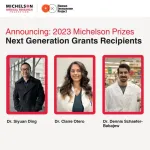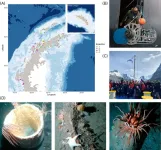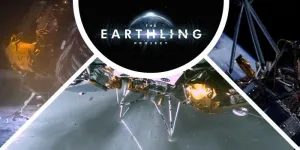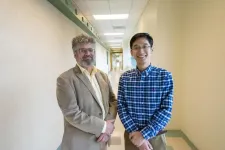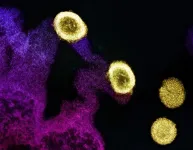(Press-News.org) When biologist Elizabeth Carlen pulled up in her 2007 Subaru for her first look around St. Louis, she was already checking for the squirrels. Arriving as a newcomer from New York City, Carlen had scrolled through maps and lists of recent sightings in a digital application called iNaturalist. This app is a popular tool for reporting and sharing sightings of animals and plants.
People often start using apps like iNaturalist and eBird when they get interested in a contributory science project (also sometimes called a citizen science project). Armed with cellphones equipped with cameras and GPS, app-wielding volunteers can submit geolocated data that iNaturalist then translates into user-friendly maps. Collectively, these observations have provided scientists and community members greater insight into the biodiversity of their local environment and helped scientists understand trends in climate change, adaptation and species distribution.
But right away, Carlen ran into problems with the iNaturalist data in St. Louis.
“According to the app, Eastern gray squirrels tended to be mostly spotted in the south part of the city,” said Carlen, a postdoctoral fellow with the Living Earth Collaborative at Washington University in St. Louis. “That seemed weird to me, especially because the trees, or canopy cover, tended to be pretty even across the city.
“I wondered what was going on. Were there really no squirrels in the northern part of the city?” Carlen said. A cursory drive through a few parks and back alleys north of Delmar Boulevard told her otherwise: squirrels galore.
Carlen took to X, formerly Twitter, for advice. “Squirrels are abundant in the northern part of the city, but there are no recorded observations,” she mused. Carlen asked if others had experienced similar issues with iNaturalist data in their own backyards.
Many people responded, voicing their concerns and affirming Carlen’s experience. The maps on iNaturalist seemed clear, but they did not reflect the way squirrels were actually distributed across St. Louis. Instead, Carlen was looking at biased data.
Previous research has highlighted biases in data reported to contributory science platforms, but little work has articulated how these biases arise.
Carlen reached out to the scientists who responded to her Twitter post to brainstorm some ideas. They put together a framework that illustrates how social and ecological factors combine to create bias in contributory data. In a new paper published in People & Nature, Carlen and her co-authors shared this framework and offered some recommendations to help address the problems.
The scientists described four kinds of “filters” that can bias the reported species pool in contributory science projects:
Participation filter. Participation reflects who is reporting the data, including where those people are located and the areas they have access to. This filter also may reflect whether individuals in a community are aware of an effort to collect data, or if they have the means and motivation to collect it.
Detectability filter. An animal’s biology and behavior can impact whether people record it. For example, people are less likely to report sightings of owls or other nocturnal species.
Sampling filter. People might be more willing to report animals they see when they are recreating (i.e. hanging out in a park), but not what they see while they’re commuting.
Preference filter. People tend to ignore or filter out pests, nuisance species and uncharismatic or “boring” species. (“There’s not a lot of people photographing rats and putting them on iNaturalist — or pigeons, for that matter,” Carlen said.)
In the paper, Carlen and her team applied their framework to data recorded in St. Louis as a case study. They showed that eBird and iNaturalist observations are concentrated in the southern part of the city, where more white people live. Uneven participation in St. Louis is likely a consequence of variables, such as race, income, and/or contemporary politics, which differ between northern and southern parts of the city, the authors wrote. The other filters of detectability, sampling and preference also likely influence species reporting in St. Louis.
Biased and unrepresentative data is not just a problem for urban ecologists, even if they are the ones who are most likely to notice it, Carlen said. City planners, environmental consultants and local nonprofits all sometimes use contributory science data in their work.
“We need to be very conscious about how we’re using this data and how we’re interpreting where animals are,” Carlen said.
Carlen shared several recommendations for researchers and institutions that want to improve contributory science efforts and help reduce bias. Basic steps include considering cultural relevance when designing a project, conducting proactive outreach with diverse stakeholders and translating project materials into multiple languages.
Data and conclusions drawn from contributory projects should be made publicly available, communicated in accessible formats and made relevant to participants and community members.
“It’s important that we work with communities to understand what their needs are — and then build a better partnership,” Carlen said. “We can’t just show residents the app and tell them that they need to use it, because that ignores the underlying problem that our society is still segregated and not everyone has the resources to participate.
“We need to build relationships with the community and understand what they want to know about the wildlife in their neighborhood,” Carlen said. “Then we can design projects that address those questions, provide resources and actively empower community members to contribute to data collection.”
END
How bias shows up in maps made with citizen science data
2024-03-05
ELSE PRESS RELEASES FROM THIS DATE:
Rice’s Nai-Hui Chia wins NSF CAREER Award
2024-03-05
HOUSTON – (March 5, 2024) – Nai-Hui Chia, an assistant professor of computer science at Rice University, has won a National Science Foundation CAREER Award to develop a new theoretical framework to facilitate the development of efficient quantum algorithms for a range of problems in quantum physics and computer science as well as enhance the security of quantum cryptography.
The highly competitive grants are awarded each year to a selective cohort of about 500 early career faculty across all disciplines engaged in pathbreaking research and committed to growing their field through outreach and education.
“Quantum computing holds immense ...
Vaginal ring and oral pre-exposure prophylaxis found safe for HIV prevention throughout pregnancy
2024-03-05
WHAT:
The monthly dapivirine vaginal ring and daily oral pre-exposure prophylaxis (PrEP) with tenofovir disoproxil fumarate and emtricitabine were each found to be safe for HIV prevention among cisgender women who started using one of them in their second trimester of pregnancy, according to findings presented today at the 2024 Conference on Retroviruses and Opportunistic Infections (CROI) in Denver. Pregnant people are estimated to be three times more likely to acquire HIV through sexual intercourse than similarly aged people who ...
Michelson Medical Research Foundation and Human Immunome Project announce 2023 Michelson Prize Laureates
2024-03-05
Michelson Medical Research Foundation (MMRF) and Human Immunome Project (HIP) have awarded Dr. Siyuan Ding (Washington University in St. Louis), Dr. Claire Otero (Weill Cornell Medicine), and Dr. Dennis Schaefer-Babajew (Rockefeller University) the Michelson Prizes: Next Generation Grants, the organizations announced today.
The $150,000 research grants are awarded annually to support early-career scientists advancing human immunology, vaccine discovery, and immunotherapy research for major global ...
New method measures the 3D position of individual atoms
2024-03-05
Since more than a decade it has been possible for physicists to accurately measure the location of individual atoms to a precision of smaller than one thousandth of a millimeter using a special type of microscope. However, this method has so far only provided the x and y coordinates. Information on the vertical position of the atom – i.e., the distance between the atom and the microscope objective – is lacking. A new method has now been developed that can determine all three spatial coordinates of an atom with one single image. This method – developed by the University of Bonn and University of Bristol ...
Cleveland Clinic-led research supports repurposing sildenafil (Viagra) for Alzheimer’s treatment
2024-03-05
CLEVELAND – New Cleveland Clinic-led research points to sildenafil (Viagra) as a potential treatment for Alzheimer’s disease. The study provides evidence from computational models, insurance claims data and observations from brain cells in Alzheimer’s patients.
Sildenafil is the main component of drugs used to treat erectile dysfunction (Viagra) and pulmonary arterial hypertension (Revatio).
“Our findings provide further weight to re-purposing this existing FDA-approved drug as a novel treatment for Alzheimer’s, which is in great need of new therapies,” ...
Antarctic researchers hitched a lift on a cruise ship, and recommend this eco-friendly, collaborative approach to remote ocean science
2024-03-05
Antarctic researchers hitched a lift on a cruise ship, and recommend this eco-friendly, collaborative approach to remote ocean science.
####
Article URL: https://journals.plos.org/climate/article?id=10.1371/journal.pclm.0000348
Article Title: New methods of undertaking marine science in Antarctica using tourism vessels
Contact: Matthew Mulrennan; matt@kolossal.org
Author Countries: Canada, United States
Funding: The authors received no specific funding for this work. END ...
Odysseus has a new home and brings the Earthling Project along for the ride
2024-03-05
March 5, 2024, Mountain View, CA – The moon lander Odysseus, known as Odie, touched down on the Moon's surface on February 22, becoming the first time the U.S. has landed on the Moon in more than 50 years and the first commercial moon lander to successfully land on the Moon. Along with its science payload, the spacecraft also brought along a fusion of art and space exploration, SETI Institute's Artist in Residence (SETI AIR), Felipe Pérez Santiago's Earthling Project, a collection of global musical compositions representing Earth's cultural ...
Painting a molecular portrait of the brain with mass spectrometry and deep learning
2024-03-05
Beckman Institute for Advanced Science and Technology researchers Jonathan Sweedler, a professor of chemistry, and Fan Lam, a professor of bioengineering, outlined how spatial omics technologies can reveal the molecular intricacy of the brain at different scales.
Their research appeared this month in Nature Methods.
The researchers and their colleagues used a biochemical imaging framework integrated with deep learning to create 3D molecular maps with cell specificity to better understand how the brain functions in health and disease. Their research is supported by a $3 million grant from ...
Semaglutide reduces severity of common liver disease in people with HIV
2024-03-05
WHAT:
A weekly injection of semaglutide was safe and reduced the amount of fat in the liver by 31% in people with HIV and metabolic dysfunction-associated steatotic liver disease (MASLD), according to a presentation today at the 2024 Conference on Retroviruses and Opportunistic Infections (CROI) in Denver. This is the first clinical trial of semaglutide for MASLD in people with HIV. The research was sponsored by the National Institute of Allergy and Infectious Diseases (NIAID), part of the National Institutes of Health, and conducted in the United States and Brazil by ACTG, a global clinical trials network focused on HIV and other infectious diseases. ...
The Lancet: Experts warn about the overmedicalisation of menopause and call for a new approach to how society views menopause and supports women as they age
2024-03-05
The Lancet: Experts warn about the overmedicalisation of menopause and call for a new approach to how society views menopause and supports women as they age
Menopause is a life stage for half the world’s population and is generally depicted in a negative way. However, women’s experiences of menopause are unique and vary hugely.
The Lancet 2024 Series on menopause argues that an over-simplified narrative of menopause as a health problem to be solved by replacing hormones is not based on evidence and deflects attention from the need for substantial societal shifts in how menopause, and midlife/older women in general, are viewed and treated around the world.
The ...


